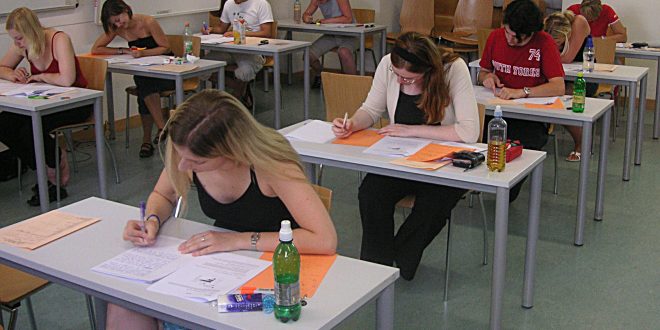By R. Brady
Swallowing anxiously, I shifted in my seat as the instructor slowly passed out the exams. I gulped again, sending a flurry of butterflies into my stomach. I took a slow, deep breath to attempt to calm my nerves and the thick packet was placed on my desk with a soft thump. I cautiously flipped to the first page, glanced at the first question, and felt my heart drop to the floor. My eyes hastily scanned the first page, and then the second. My breaths became quicker and quicker as I peeked at classmates around me. Some had the same confused, anxious look on their faces. Looking back at the test, I read the first question for what seemed like the one hundredth times. Each time left me feeling more and more confused and helpless. I tried to rack my brain for an answer, but each question drew blanks. Our class didn’t learn this, I realized, and I dreaded having to guess my way through the entire first two pages of the final exam.
Last semester, I took a class that had two teachers for the same subject. I didn’t think it would be a problem until I opened that thick packet on the second day of final exams. The teacher that I had had for the class taught the information slower, so the other class with a different teacher was ahead of us. On the final exam, the first two pages contained information that our class hadn’t learned.
Because of this experience, I think that in subjects with multiple teachers, the best solution is to have each teachers write their own exams to ensure that their students will know all of the information on the test. This way, nerve-racking situations such as mine can be avoided and students will be prepared for their final exams.
A friend and classmate of mine had the opposite experience and therefore holds a different stance on the issue. Another course that all students in our grade took also had two teachers. We each had different teachers, so our experiences with the tests were very different. While I thought my teacher had given an easy test, my friend found her teacher’s exam difficult. My friend’s stance on the issue is that giving the same exam to both classes is the most fair way to test students.
After pondering both sides of the issue, I have come to the conclusion that a compromise may be the best answer. Although I still tend to lean towards the side of the argument that there should be different tests for different teachers, I respect and understand that this is not always the most fair way to test students. One possible solution is giving the same test but having both teachers make sure all of the material was covered in both classes. This predicament may just be a situation where one students benefits and another suffers, but a compromise could solve the problem. Whether your recent final experiences were positive or negative, it is important for students to provide feedback on exams to teachers and for teachers to consider that feedback and fix the problems so that the same negative experiences won’t happen again in the future.
 Tempus Magazine By Students, For Students
Tempus Magazine By Students, For Students 



